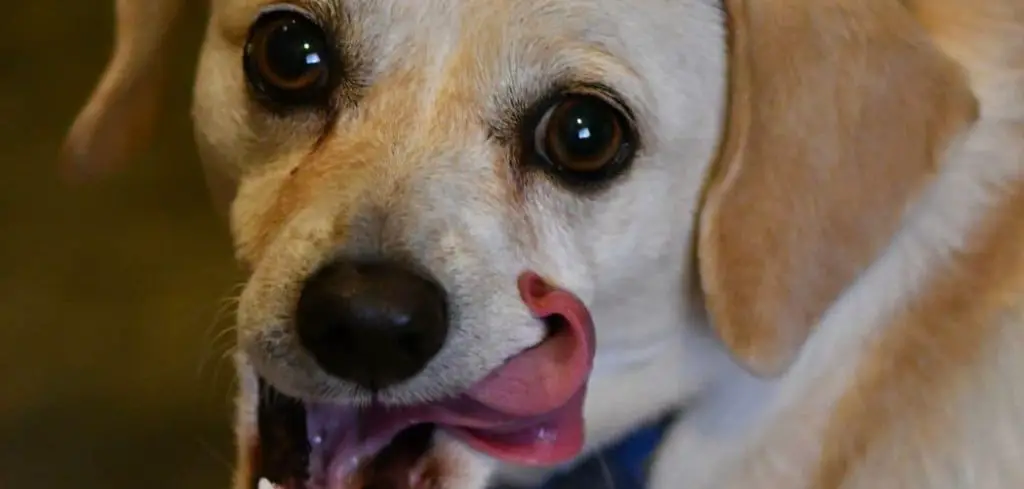Excessive licking of a paw pad can signal discomfort, irritation, or an underlying health issue in dogs.
While occasional licking is normal, frequent or persistent licking that results in redness, swelling, or sores should not be ignored.
We outline the common reasons for a dog excessively licking their paw pad, what you can do at home, and when to seek veterinary help.
Dog Excessively Licking Paw Pad — Why It Happens
A dog excessively licking their paw pad is often a response to irritation, pain, or itchiness. Dogs may lick to relieve discomfort from allergies, clean minor wounds, or cope with stress or boredom. In some cases, licking becomes a habit, but repeated licking can worsen inflammation, trigger infections, and cause hair loss or sores.
Environmental irritants, dietary sensitivities, parasites, or arthritis may also contribute, making it important to monitor your dog closely.
Recognizing whether the behavior is linked to physical discomfort or anxiety is key to effective management and treatment.

Dog Excessively Licking Paw Pad: Common Causes
Allergies
Allergies are a common reason dogs excessively lick their paw pads. Food allergies or environmental triggers like pollen, dust, or chemicals can cause itchiness and inflammation.
A dog may focus on a paw pad that is particularly sensitive, leading to redness, swelling, and hair loss.
Managing allergies with dietary adjustments, limiting exposure to triggers, and using veterinarian-recommended medications can reduce paw licking and improve comfort.
Read more: Dog Excessively Licking Paws and Legs (Here’s Why)
Skin Infections
Bacterial or fungal infections often develop on paw pads due to moisture, dirt, or minor injuries.
Dogs lick infected paw pads to relieve itching and discomfort, which can worsen the infection. Signs include redness, oozing, foul odor, and thickened skin.
Prompt veterinary care, including medicated washes or antibiotics, is crucial to prevent complications and promote healing.
Injuries or Foreign Objects
Cuts, splinters, thorns, or abrasions can cause localized pain. Licking acts as a self-soothing and cleaning mechanism for dogs.
You might notice limping, tenderness, or visible wounds. Immediate inspection, cleaning, and protective measures such as bandaging or an Elizabethan collar can help prevent infection and encourage healing.
Parasites
Fleas, ticks, or mites can irritate the paw pads, triggering licking. Parasite bites often cause localized itchiness, redness, and swelling.
Other signs include hair loss, scabbing, or constant scratching in addition to licking.
Effective parasite prevention and treatment are essential to stop persistent irritation and reduce the risk of secondary infections.
Behavioral or Stress-Induced Licking
Some dogs lick paw pads compulsively due to anxiety, boredom, or stress. Nighttime or repetitive licking without clear physical causes often indicates a behavioral component.
Signs may include pacing, whining, or licking in repetitive patterns. Enrichment activities, mental stimulation, and establishing a calm environment can help manage stress-related licking.
Arthritis or Joint Pain
In older dogs, joint discomfort can lead to licking paw pads near affected joints.
Licking serves as a coping mechanism for pain or stiffness. You may notice limping, stiffness, or difficulty standing.
Veterinary evaluation can provide pain management strategies and lifestyle adjustments to reduce discomfort and prevent further licking.
What to Do If Your Dog Is Excessively Licking Their Paw Pad
Observe your dog carefully to determine whether licking is caused by medical issues or stress. Monitoring frequency, timing, and affected areas can provide important clues.
Keep paw pads clean and dry. Rinse your dog’s paws after outdoor activities, remove debris, and thoroughly dry them to prevent moisture-related irritation or infections.
Redirect licking with safe alternatives. Chew toys, treat puzzles, or interactive toys can occupy your dog’s attention and reduce stress-induced licking. Avoid scolding, which can exacerbate anxiety.
Check for signs of infection or injury. Redness, swelling, discharge, or open sores require veterinary evaluation to prevent worsening conditions.
Adjust environmental or dietary factors. Switching to hypoallergenic foods and minimizing contact with irritants can reduce triggers for licking paw pads.
Provide mental stimulation and calming routines. Exercise, interactive play, and a consistent bedtime routine can reduce stress-driven paw licking and improve overall behavior.
When to Call or Visit Your Vet
Seek veterinary attention if paw pad licking is accompanied by bleeding, severe swelling, pus, or signs of systemic illness such as lethargy, loss of appetite, or fever.
Persistent licking that does not improve with at-home care, or licking that causes open sores, warrants a professional evaluation. Veterinarians can diagnose infections, allergies, injuries, or other medical conditions. Early intervention prevents complications, promotes healing, and ensures your dog’s comfort.
Veterinary care may include diagnostic testing, topical or oral medications, and behavioral guidance to manage compulsive licking. Prompt treatment can prevent chronic irritation and improve your dog’s quality of life.
Read more: Dog Licking Paws Excessively (What it means and what to do)
Key Takeaway
Excessive licking of a paw pad can result from allergies, infections, injuries, parasites, pain, or behavioral stress. Observing your dog, keeping paw pads clean, and addressing environmental triggers are key first steps.
Veterinary evaluation is essential if licking is severe, persistent, or accompanied by signs of infection or discomfort.
With careful observation, preventive care, and professional guidance, you can reduce paw pad licking, improve comfort, and support your dog’s overall health and well-being.
Identifying the underlying cause allows you to take proactive steps to prevent further irritation and enhance your dog’s quality of life.
